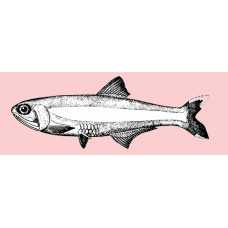Latin name
Anchoa hepsetus
Other names
Broad-striped anchovy; French: anchois rayé; Spanish: anchoa legìtima.
Identification
The striped anchovy has a ribbon-like stripe along each side and some yellow near the head. Anchovy species are difficult to distinguish, the striped anchovy differs in its fin rays and pigmentation: it has 14-17 dorsal fin rays, 15-18 pectoral fin rays and 20-24 anal fin rays, as well as melanophores framing all its dorsal scales.
Distribution
Striped anchovies are found in the western Atlantic, occurring from Massachusetts to Fort Pierce Florida, in the northern Gulf of Mexico, rarely in southern Florida and not in the Florida Keys.
Habitat
Striped anchovies form dense schools and prefer coastal shallow waters, including bays and coves, and can tolerate a wide range of salinity.
Size
The average length of a Striped Anchovy does not exceed 4 inches, can reach 6 inches.
Life history and Behavior
The striped anchovy spawns from April through July in harbors, estuaries, and bays. Eggs of both species are round and float near the surface, hatching a few days after release. Juveniles mature in 3-4 years.
Food and feeding habits
They feed on plankton.
Reproduction
It makes anadromous migrations to rivers (up to 100 km upstream). It spawns in the Orinoco delta in May. Males mature at 4.8 cm in length, females at 7.7 cm.
| Classification | |
| Phylum | Chordata |
| Class | Actinopterygii |
| Family | Engraulidae |
| Genus | Anchoa |
| Species | A. hepsetus |
| Features | |
| Conservation status | Least Concern |
| Habitat | Pelagic |
| Life span, years | No information |
| Maximum body weight, kg | 0.019 |
| Maximum length, cm | 15 |
| Sailing speed, m/s | No information |
| Threat to people | Edible |
| Way of eating | Predator |
Striped Anchovy
Tags: Striped Anchovy


